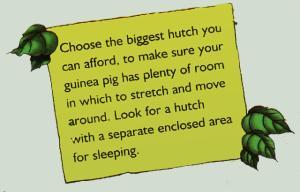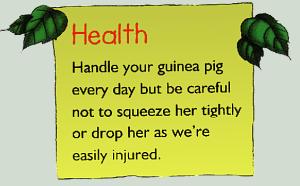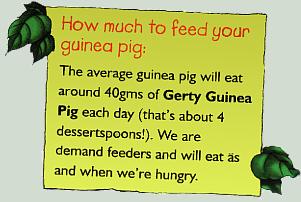|
THE HISTORY OF GUINEA PIGS
The scientific name for guinea pig is Cavia Porcellus
meaning pig like cavy. They belong to the rodent family.
The original colour is golden agouti. They do not
originate from Guinea as we would suppose but came
from South America. Their native home is the mountains
and grasslands of Peru, Argentina, Brazil and Uruguay.
The Inca's bred them for consumption and for offering
as sacrifices to their gods. There is some dispute
as to when they first arrived in Europe, some reports
tell of the Spaniards bringing them home with them
at the beginning of the sixteenth century. Others
believe that English seamen brought them to Europe
later on that century. By the beginning of the eighteenth
century they were being kept widely as exotic pets
of the wealthy. The name guinea is thought to have
derived from the monitory unit the guinea as it is
believed that was the price of the first guinea pigs
to reach the pet market. This was a lot of money in
those days. Pig, is thought to have been used because
the animals were seen to be rooting through the undergrowth
for food just like the farmyard pig.
Today there are many guinea pigs kept as pet's world-wide.
They are said to be the most popular pet of all the
rodents.

HOUSING
When you have chosen your guinea pigs you will need
to consider their housing. They will need a clean,
dry, secure hutch. The very minimum requirement
for two guinea pigs is 48"x18"x18",
but the bigger the better. Two storey hutches
with a ramp provide added interest, exercise and extra
space. The positioning should be carefully considered
too, it should be placed out of bright sunlight and
away from draughts. If the hutch is placed in draughts
your guinea pigs can easily get colds or eye infections.
If the hutch is in direct sunlight your guinea pigs
will be exposed to heat stroke. The golden rule to
remember is that guinea pigs do not like the extreme
weather conditions. Most people prefer to bring the
hutch into a utility room or shed for the winter away
from the cold, it is also important not to forget
that extreme heat can be just as harmful. DO
NOT put the hutch in a garage that you are
currently using for your vehicle, exhaust fumes are
lethal.

(Please see above for minimum requirement.)
Many people prefer to keep their guinea pigs as indoor
pets. This is fine. An indoor plastic cage is available
for this purpose. It has a solid plastic base and
a plastic coated wire top with a lift of lid. If you
are planning to keep your guinea pigs in this way
please do remember to give them a box or igloo that
they can hide in. Unlike an outdoor hutch that has
a separate bedroom an indoor hutch is open on all
four sides and can be very frightening for a guinea
pig if it has no place to hide.
Whether your guinea pigs are indoor or outdoor guinea
pigs they will need an outdoor run so that they can
be placed outside on good days to graze on the grass.
This is a guinea pigs favorite past time. There are
many types of runs for sale you must decide which
is most convenient for your needs. Always use a covered
run so as to keep your guinea pigs safe from predators
such as cats, dogs, foxes and large wild birds. Unlike
rabbits guinea pigs do not dig holes in the lawn and
tunnel out. DO NOT put the run on a
lawn that has recently been treated with weed killer
or fertilizer or has been urinated on by the family
dog.

BEDDING
There are several different materials that can be
used. Bedding serves two purposes, to soak up the
urine and to provide warmth. The most commonly used
bedding being a layer of newspaper on the floor of
the hutch with a deep (1"- 2") covering
of woodshaving and a layer of hay on top. The idea
behind the newspaper is that you lift the soiled bedding
out in one to discard it. Straw can be used but take
care that is not too hard as this can damage to a
guinea pigs eyes. If you get woodshavings from a timber
merchant take care to ensure that it has not been
treated with any chemicals. The hutch should be cleaned
out at least every three days and thoroughly scrubbed
with disinfectant every month.

Toys
Unlike rabbits guinea pigs do not usually play with
toys. What they do like are places to hide and tunnels
to play in. Cardboard boxes are ideal as they can
be discarded when soiled. Cut holes on all four sides
of a box and watch your guinea pigs play. Plastic
pipes that are used for drainage are excellent toys.
Rody Igloos are available from pet shops and from
us, we find that the guinea pigs love these. One way
to interest your guinea pigs is to thread a carrot,
apple or baked bread on a string and hang it on the
cage. Remember guinea pigs do not climb so do not
hang it too high, just enough to make them work at
it.
It is a good idea to provide a branch from an apple
tree or willow tree. This will give your guinea pigs
something to play with and also a way of keeping their
teeth healthy and strong. A mineral block can be suspended
from the hutch not only will this provide essential
minerals it will help occupy the guinea pigs.
TAKING YOUR GUINEA PIGS HOME
When you first get your guinea pigs home put them
into their hutch and leave them alone to get used
to their new home, Do not handle them in the first
few days as they will be very frightened. After the
first few days begin to offer them tasty tit-bits
from your hand to help build up their confidence.
When you feel that they are beginning to trust you
then you can lift them out of the hutch. Put one hand
under the abdomen and scoop the rear up with the other
hand. Place them onto your chest with their feet flat
against you. Hold them firmly but not too tight as
guinea pigs are very fragile. It is advisable for
children to be sitting on the ground when handling
a guinea pig for the first time, if the animal is
dropped it will not have so far to fall and should
not get hurt. Always be quiet and calm when holding
your guinea pigs, talk gently to them to reassure
them, they will soon learn to trust you and start
to chatter back to you.
When returning them to their cage hold them firmly
as they will usually try to leap out of your arms
back into the hutch.
FEEDING
Your guinea pigs diet should be made up of dried food,
fresh greens and fresh hay. They should receive daily
amounts of all three. Fresh water should be freely
available at all times. Water bottles that are suspended
from the cage is the best way of ensuring that your
guinea pig has constant fresh water. Water bottles,
including the spouts, should be cleaned with a bottlebrush
regularly to prevent the build up of algae, which
is harmful to your guinea pigs digestive system. Bottles
and tops can be sterilised in baby bottle sterilising
solution once in a while for extra cleanliness. Bowls
are easily tipped over or soiled.
To maintain a healthy guinea pig it will need a diet
high in vitamin C. If you choose a good quality dried
GUINEA PIG food it will contain vitamin C. If you
choose the RABBIT AND GUINEA PIG mix it will say in
minute writing somewhere on the packet out of view
that if this mix is fed to guinea pigs vitamin C must
be added to the drinking water. This is so easily
overlooked resulting in a poorly guinea pig. So do
take the time to choose carefully. We use GERTY GUINEA
PIG and can highly recommend it, it is readily available
from nearly all pet shops. Do not buy dried food in
large quantities unless you are sure it will be used
up within three months, vitamin C deteriorates the
longer it is kept. Always check the sell by date on
the packet.
Hay is the most beneficial of all the dried foods.
It is important that your guinea pigs have access
at all times to clean, fresh hay. The best way of
ensuring that it is kept clean is to provide a hayrack.
Hay that is put on to the floor of the hutch quickly
becomes trampled and soiled.

Other dried foods that can be given m moderation as
treats are broken dog biscuits, peanuts, sunflower
seeds, breakfast cereals, crackers and bread that
has been baked hard in the oven. All foods should
be fed in a heavy-based bowl that will not tip over.
Feeding bowls will need to be washed regularly as
guinea pigs often foul their bowls.
There are many fresh foods that can be fed safely.
Always make sure the greens are fresh and clean, not
withered, mouldy or that have been sprayed with a
chemical. I suggest that you invest in or borrow from
the library a good wild plant book. It is very rewarding
to feed wild plants as the guinea pigs love them.
There are lots of fresh foods that can be fed from
the kitchen too, again make sure they are fresh and
clean. Do not feed fruit and vegetables that you would
not consider fit for human consumption. I have listed
a few common 'safe' and 'unsafe' plants, but
IF IN DOUBT LEAVE IT OUT.
SAFE PLANTS
Broccoli, Beetroot (Not the leaves), carrots, carrot
tops, parsnips, Swedes, turnips, cabbage, cauliflower,
cauliflower leaves, banana, banana skins, celery,
celery tops, Chinese leaves, cucumber, parsley, peas,
spinach, watercress, apples and pears (without the
pips), melons, agrimony, avens, chickweed, clover,
coltsfoot, comfrey, cow parsley, dandelion (in small
quantities as it is a natural laxative), goatsbeard,
groundsel, goosegrass, hawkweed, mallow, meadowsweet,
nipplewort, plantains, shepherds purse, sow thistles,
trefoils, vetches, yarrow and lettuce (only in small
amounts as it is a natural diuretic).
UNSAFE FOODS
Any plants that are grown from a bulb, all evergreen
trees and shrubs, anenome, bracken, bryony, buttercup,
celandine, charlock, convulvus, deadly nightshade,
dogs/herb mercury, foxglove, hellebore, hemlock, henbane,
horsetails, ivy, laburnum, lily of the valley, mayweed,
milkweed, monkshood, meadow saffron, wild and beaked
parsley, poppy, privet, ragwort, rhodedendron, rhubarb,
scarlet pimpernel, snowberry, spurges, toadflax, travellors
joy, yew and most docks. Certain docks can be fed
but it is so difficult to tell them apart it is best
to omit them altogether.
ARGUABLE
FOODS
There are some foods that are arguable as to whether
they are safe, or even healthy for our little friends.
A couple of these are Tomatoes and Potatoes. We would
suggest if you do feed these, that it is in small
quantities and not to often.
|